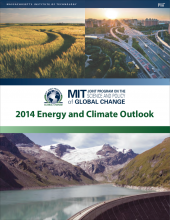MIT News Release: Report: Unless we change direction, the future world will be 3–5°C warmer, thirstier, still dependent on fossil fuels
The 2014 Energy and Climate Outlook provides an integrated assessment of how human activities, given our current development path, are interacting with complex Earth systems and ultimately affecting the natural resources on which we depend. It uses a projection modeling system developed by MIT’s Joint Program on the Science and Policy of Global Change, the Integrated Global Systems Model (IGSM) framework, to determine the associated energy, climate, atmosphere, ocean, and land-use implications. We provide a projection, not a prediction, as the future will ultimately be determined by actions taken over the next decades that are intended to stabilize our relationship with the planet.
We incorporate the emissions targets currently proposed by the international community to address the challenges of climate change. The United Nations Framework Convention on Climate Change (UNFCCC) reached an accord in 2009 for the so-called Copenhagen pledges, which were further specified in the Cancun agreements. These pledges are set to expire in 2020. Our objective is to show how far the current 2020 pledges take us, and what is at risk if we fail to push beyond these emissions reduction goals.
Key findings in the 2014 Outlook
Supplemental data for the Outlook includes a detailed set of projections through the year 2050 for each of 16 major regions of the world. We provide this numerical data in the hopes that researchers and policymakers will find them useful for their own analyses.
Download: Outlook 2014 data tables
Changes in Energy and Emissions:
With emissions stable and falling in developed countries, on the assumption that Copenhagen-Cancun pledges are met and retained in the post‑2020 period, future emissions growth will come from the Other G20 and developing countries.
- Growth in global emissions results in 77 Gt CO2-equivalent emissions in 2050, rising to 92 Gt by 2100—nearly doubling 2010 emissions. By 2050, developed countries account for about 15% of global emissions, down from 30% in 2010.
- CO2 emissions from fossil fuels remain the largest source of GHGs. Other greenhouse gas emissions and non‑fossil energy sources of CO2 account for almost 33% of total global GHG emissions by 2100 (down slightly from previous estimates).
- In 2050, electricity and transportation emissions will account for nearly 52% of global CO2 emissions from fossil fuel use (decreasing slightly from 56% in 2010).
- Through 2050, fossil fuels continue to account for over 80% of primary energy, despite rapid growth in renewables and nuclear (in part because the natural gas share of primary energy also increases).
Changes in Climate:
We predict accelerated changes in global and regional temperatures, precipitation, land use, sea level rise and ocean acidification.
- Global mean surface temperature increase ranges from 1.6–2.6°C by 2050 (relative to the 1901–1950 mean), and 3.3–5.6°C by 2100.
- Global mean precipitation increase ranges from 4.1–5.3% by 2050 (relative to the 1901–1950 mean), and 7.5–12.4% by 2100.
- Thermal expansion and land glacier melting contribute 0.08–0.12 meters to sea level rise by 2050, and 0.25 to 0.44 meters by 2100.
- More carbon in the ocean leads to increasing acidity—average ocean pH drops from 8.03 in 2010 to about 7.85 pH by 2100.
Changes in Water Flows:
Annual freshwater flow increases globally by about 15% by 2100.
- Total water withdrawals are projected to increase by about 19% by 2100 (from 2,700 billion cubic meters (bcm) to 3,200 bcm). At this level, withdrawals would account for about 6% of the annual freshwater flow.
- We assume no changes in irrigated lands and, as a result, withdrawal for irrigation falls slightly (from 1,551 to 1,389 bcm). Withdrawals for domestic use of water doubles (from 348 to 698 bcm) and industrial use of water increases by almost 45% (from 763 to 1,098 bcm).
- We calculate both consumption (water evaporated or consumed, and not returned to the river basin) and withdrawals (consumption plus return flow). By our annual consumption projections, in 2100 irrigation will use nearly 1,000 bcm while industrial and domestic will each use just over 200 bcm. Globally, this level of consumption is 2.5% of the projected total annual freshwater flow.
- Because location and timing of flows is important, withdrawals and consumption as a percentage of total annual flows can provide a misleading picture of the adequacy of water resources. Seasonality of precipitation often means the timing of flows does not match needs.
- By 2100, our scenarios show reduced water stress in some parts of North America, China and the Middle East. Despite abundant global supply, they also show increased water stress in parts of India, China, Pakistan, Turkey, North Africa, South Africa and the U.S.
- Water requirements increasing with population and GDP can have a stronger effect than climatic changes on water stress, especially in developing countries, where economic and population growth can be strong drivers of water requirements. Where growth occurs, inter-basin transfers, added water storage, and conservation and efficiency measures are possible responses to increased stress.
- Projections of regional precipitation patterns, runoff control processes and water requirements are highly uncertain and have strong interannual and decadal variability. More rigorous uncertainty analysis is needed to fully understand likelihoods of specific water resource outcomes.
Expectations for the 2015 UN Climate Agreement:
- Likely efforts will further bend the curve of emissions growth, with an estimate of 68 Gt CO2‑eq emissions in 2050—about 9 Gt less than our Outlook estimate for 2050.
- Unless the post‑2020 agreement is significantly more stringent than we speculate, the emissions path will diverge further from what the Intergovernmental Panel on Climate Change (IPCC) Working Group III shows to be consistent with stabilization to 530–580 CO2‑equivalent GHG concentrations by 2100.
- On this emissions path, by 2030 the world will be within about 7 years of hitting cumulative emissions levels that the IPCC Working Group I shows to be consistent with a 50% chance of holding temperature increase below 2°C.



